 |

| |
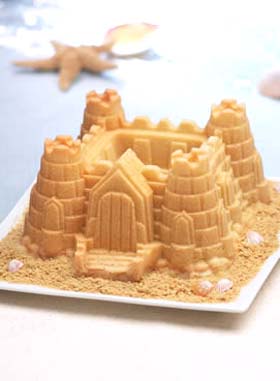
The beautiful Castle Bundt is a long evolution from the original fluted bundt pan (see photo below). Photography courtesy of Nordicware. |
| WHAT IT IS: Gourmet cake mixes and decorative Bundt cake pans. |
| WHY IT’S DIFFERENT: The gourmet cake mixes have not one-dimensional flavors, but complex elements. Combined with the festive new Bundt pan designs, edible masterpieces can be made by anyone. |
| WHY WE LOVE IT: It couldn’t be easier to make something this impressive. (That’s what specialty food is all about!) |
| WHERE TO BUY IT: NordicWare.com. |
|
|
 |

Nordicware Bundt Cakes
Page 5: Bundt Pan History
This is Page 5 of a five-page review. Click on the black links below to visit other pages.
INDEX OF REVIEW
MORE TO DISCOVER
|
The History Of The Bundt Pan
The Bundt pan was created in 1950 by H. David Dahlquist, the founder of Minneapolis-based Nordic Ware, a manufacturer of kitchenware products. He did so at the request of Rose Joshua and Fannie Schanfield, members of the Minneapolis chapter of Hadassah, a Jewish women’s service organization.
According to an article in the Fall 2005 issue of Generations, the newsletter of the Jewish Historical Society of the Upper Midwest, Fannie remembers a Hadassah luncheon when Rose lamented the quality of light and fluffy American-style cakes, and longed for the rich, dense cakes of her European childhood. These, however, required a special type of of pan—one with a hole in the center that allowed heat to penetrate heavy cake batter from all sides. With this type of form, a heavier batter could be baked without leaving under-baked dough in the center.
Fannie’s husband arranged a meeting with Dahlquist, and Rose joined her to show Rose’s mother’s ceramic kugelhopf cake pan. This became the prototype for the Bundt pan (a contemporary aluminum version of the kugelhopf is shown in the photo at the right).
Dahlquist modified the design by introducing folds in the fluted edges, and fashioned the pan out of aluminum. Some months later, a dozen Nordic Ware factory “seconds” were delivered to Hadassah member Mary Juster’s home, and Hadassah sold the pans to members for $4.00 each.
|
|
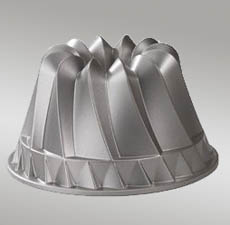 A contemporary version of the kugelhopf, the basis for the bundt, available at Amazon.com. A contemporary version of the kugelhopf, the basis for the bundt, available at Amazon.com. |
The History Of THe Kugelhopf
The original kugelhopf, a Viennese specialty, is a sweet yeast-bread similar to brioche and panettone; the traditional version usually contains yeast, raisins or currants and is topped by a snowy layer of powdered sugar. It was a favorite of the Austrian princess Marie Antoinette.
Over the years, denser cakes were baked in the same fluted molds. The original molds were earthenware; later molds were made of glass or metal. The name kugelhopf derives from the German word Kugel, meaning round or ball (“Kugelkopf,” with a “k,” means “spherical head”), although the actual kugelhopf somewhat resembles a pleated hat like a turban or toque.
|
|
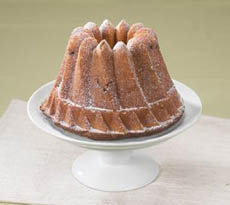
Kugelhopf. |
How The Bundt Got Its Name
The way the story is told, the name bundt comes from the German word bund, which means “community” or “a gathering of people”; and that Dahlquist just added the letter “t” to the end and trademarked the word.
However, there is a citation for a “bundt form” as early as the 1903 edition of the famous Milwaukee Settlement Cookbook*, 63 years before Dahlquist filed for his trademark on March 24, 1966. One can imagine that the Jewish women of Milwaukee had the cookbook and asked for a bundt pan. Still, Dahlquist was granted the patent.
|
|
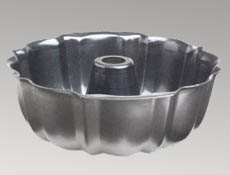
A contemporary version of the kugelhopf, the basis for the bundt. This Nordic Ware Pro Bundt is available at Amazon.com. |
*In the 1903 Milwaukee Settlement Cookbook, “Bundt form” is found on page 319 in the following text (under BUNDT KUCHEN, No. 2): “Grease Bundt form (a heavy round fluted pan with tube in center) well, and flour lightly. Cream butter and sugar well, add beaten yolks and beat, then the raised mixture and the rest of the flour, and lastly the beaten whites. Pour in pan, let rise until very light, and bake until well done and brown in a moderately hot oven, about forty-five minutes.” (Read details of the Settlement Cookbook source material). The Settlement Cookbook, first published in 1901 in Milwaukee to raise funds for the Settlement House for immigrants, is considered to be the most successful fund-raising cookbook in American history. It is still in print; the 1976 edition was named to the James Beard Cookbook Hall of Fame |
|
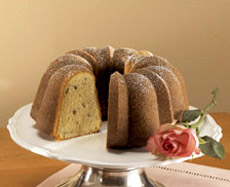
Bundt cake. |
In 1960, the Good Housekeeping Cookbook showed a pound cake baked in a Bundt pan; that feature turned the Bundt into the number-one selling cake pan in America. But it was the 1966 Pillsbury Bake-Off, where the Tunnel of Fudge Cake recipe baked in a Bundt won second place, that launched the Bundt trend.
Go To The Article Index Above
Do you have friends who would enjoy THE NIBBLE?
Click here to send them an invitation to sign up for their own copy. |
ABOUT THE NIBBLE. THE NIBBLE™, Great Food Finds™, is an online magazine about specialty foods and the gourmet life. It is the only consumer publication and website that focuses on reviewing the best specialty foods and beverages, in every category. The magazine also covers tabletop items, gourmet housewares, and other areas of interest to people who love fine food. This e-mail from the editors features the top food pick of the week. You can read the complete magazine and past issues at TheNibble.com.
© Copyright 2004-2025 Lifestyle Direct, Inc. All rights
reserved. All information contained herein is subject to change at any time
without notice. All details must be directly confirmed with manufacturers, service
establishments and other third parties. The material in this newsletter may not
be reproduced, distributed, transmitted, cached, or otherwise used, except with
the prior written permission of Lifestyle Direct, Inc.
|
 |
|
 |









